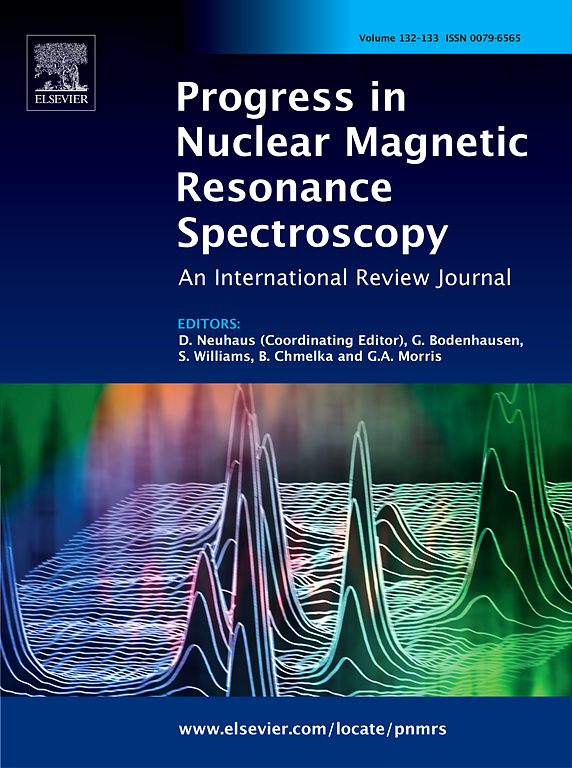零至超低场核磁共振
IF 8.2
2区 化学
Q2 CHEMISTRY, PHYSICAL
Progress in Nuclear Magnetic Resonance Spectroscopy
Pub Date : 2025-02-15
DOI:10.1016/j.pnmrs.2025.101558
引用次数: 0
摘要
零场和超低场核磁共振(ZULF NMR)是一种核磁共振模式,在分子和材料内部的自旋-自旋相互作用比塞曼相互作用强的场中进行实验。这通常发生在微特斯拉强度或更低的外场,比地球场小得多。在ZULF NMR中,自旋-自旋耦合和自旋弛豫速率的测量提供了一种非破坏性的方法来识别化学品和化学碎片,并进行样品或过程分析。由于缺乏由强外部磁场施加的对称性,使得实验能够利用高场核磁共振抑制的核自旋哈密顿量中的术语,这反过来又在广泛的领域开辟了新的能力,从寻找暗物质到制备用于临床成像的超极化造影剂。此外,在ZULF核磁共振中,拉莫尔频率通常在音频波段,核自旋可以用直流磁场脉冲操纵,并且使用高灵敏度的磁力计进行检测。与高场核磁共振相比,低频信号很容易通过导电材料,如金属,非均质样品不会导致共振线展宽,这意味着高分辨率光谱是可能的。ZULF核磁共振光谱的显著实用优势是低成本和相对简单和便携的光谱仪系统。近年来,由于磁力计灵敏度和商业可用性的提高,以及超极化方法的发展,ZULF NMR变得更容易获得,超极化方法提供了一种简单的方法,可以将信号强度提高几个数量级。对这些主题进行了回顾,并对ZULF-NMR研究的潜在未来途径进行了展望。本文章由计算机程序翻译,如有差异,请以英文原文为准。

Zero- to ultralow-field nuclear magnetic resonance
Zero and ultralow-field nuclear magnetic resonance (ZULF NMR) is an NMR modality where experiments are performed in fields at which spin–spin interactions within molecules and materials are stronger than Zeeman interactions. This typically occurs at external fields of microtesla strength or below, considerably smaller than Earth’s field. In ZULF NMR, the measurement of spin–spin couplings and spin relaxation rates provides a nondestructive means for identifying chemicals and chemical fragments, and for conducting sample or process analyses. The absence of the symmetry imposed by a strong external magnetic field enables experiments that exploit terms in the nuclear spin Hamiltonian that are suppressed in high-field NMR, which in turn opens up new capabilities in a broad range of fields, from the search for dark matter to the preparation of hyperpolarized contrast agents for clinical imaging. Furthermore, as in ZULF NMR the Larmor frequencies are typically in the audio band, the nuclear spins can be manipulated with d.c. magnetic field pulses, and highly sensitive magnetometers are used for detection. In contrast to high-field NMR, the low-frequency signals readily pass through conductive materials such as metals, and heterogeneous samples do not lead to resonance line broadening, meaning that high-resolution spectroscopy is possible. Notable practical advantages of ZULF NMR spectroscopy are the low cost and relative simplicity and portability of the spectrometer system. In recent years ZULF NMR has become more accessible, thanks to improvements in magnetometer sensitivity and commercial availability, and the development of hyperpolarization methods that provide a simple means to boost signal strengths by several orders of magnitude. These topics are reviewed and a perspective on potential future avenues of ZULF-NMR research is presented.
求助全文
通过发布文献求助,成功后即可免费获取论文全文。
去求助
来源期刊
CiteScore
14.30
自引率
8.20%
发文量
12
审稿时长
62 days
期刊介绍:
Progress in Nuclear Magnetic Resonance Spectroscopy publishes review papers describing research related to the theory and application of NMR spectroscopy. This technique is widely applied in chemistry, physics, biochemistry and materials science, and also in many areas of biology and medicine. The journal publishes review articles covering applications in all of these and in related subjects, as well as in-depth treatments of the fundamental theory of and instrumental developments in NMR spectroscopy.

 求助内容:
求助内容: 应助结果提醒方式:
应助结果提醒方式:


